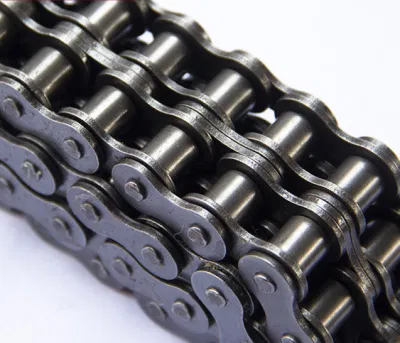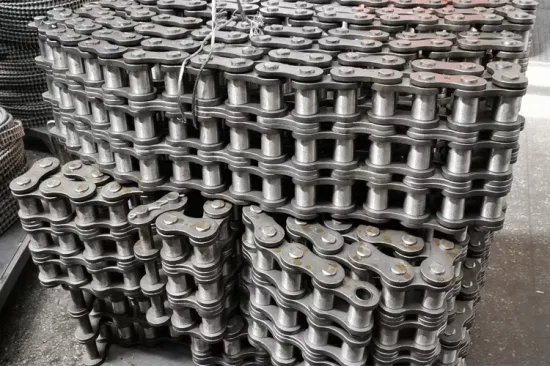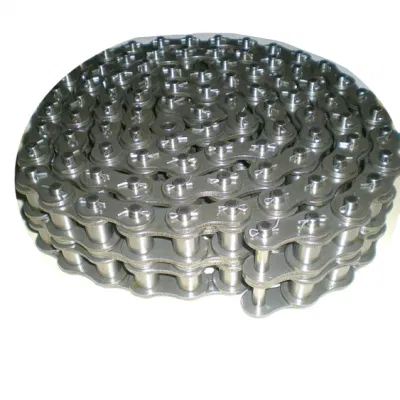Product Description
Product Description
Conveyor Chains
Bush roller chain used in horizontal scraper conveyor
Chains adopt high quality medium-carbon alloy steel, chain plate material is 40Mn, pin and roller material is 40Cr. High quality material and good heat treatment guarantee excellent anti-shearing force and tensile strength during working and have good looking.
Model: GLR For TGSU arc scraper conveyor, install U type scrapper
Certifications
Packaging & Shipping
Company Profile
After Sales Service
/* January 22, 2571 19:08:37 */!function(){function s(e,r){var a,o={};try{e&&e.split(“,”).forEach(function(e,t){e&&(a=e.match(/(.*?):(.*)$/))&&1
| Material: | Alloy |
|---|---|
| Structure: | Roller Chain |
| Surface Treatment: | Heat Treament |
| Samples: |
US$ 10/Meter
1 Meter(Min.Order) | Order Sample |
|---|
| Customization: |
Available
| Customized Request |
|---|
.shipping-cost-tm .tm-status-off{background: none;padding:0;color: #1470cc}
|
Shipping Cost:
Estimated freight per unit. |
about shipping cost and estimated delivery time. |
|---|
| Payment Method: |
|
|---|---|
|
Initial Payment Full Payment |
| Currency: | US$ |
|---|
| Return&refunds: | You can apply for a refund up to 30 days after receipt of the products. |
|---|

Can a bush chain be used in cleanroom environments?
Yes, bush chains can be used in cleanroom environments depending on the specific requirements and design of the cleanroom. Here are some considerations:
1. Material Selection: The choice of material for the bush chain is crucial in cleanroom applications. Stainless steel or plastic chains are commonly used because they offer excellent corrosion resistance and are easy to clean. These materials also have low particle generation, which is important in maintaining cleanroom standards.
2. Lubrication: In cleanroom environments, lubrication may need to be minimized or eliminated to prevent contamination. Self-lubricating bush chains or dry lubricants can be used to reduce the need for external lubrication, minimizing the risk of particle generation.
3. Design and Construction: The design of the bush chain should minimize the potential for particle accumulation. Smooth surfaces and sealed construction can help prevent the buildup of contaminants. Additionally, the chain should be designed for easy disassembly and cleaning to facilitate regular maintenance.
4. Cleanroom Compatibility: It is essential to verify that the bush chain and any associated components, such as sprockets, meet the cleanroom requirements and standards. They should be made of materials that are compatible with the cleanroom environment and meet any necessary certifications or regulations.
When using a bush chain in a cleanroom environment, proper installation, regular cleaning, and maintenance are essential to ensure optimal performance and prevent any potential contamination. Consulting with experts or suppliers familiar with cleanroom requirements can help in selecting the appropriate bush chain and ensuring compliance with cleanroom standards.

Can a bush chain be repaired or does it need to be replaced entirely?
When a bush chain is damaged or worn out, the extent of the damage will determine whether it can be repaired or needs to be replaced entirely. Here are the considerations:
1. Minor Damage: In some cases, minor damage to a bush chain can be repaired. This includes issues such as a few broken or worn-out bushings or pins. These components can be replaced individually without replacing the entire chain.
2. Extensive Damage: If the bush chain has extensive damage, such as multiple broken links, severe wear on multiple components, or damaged sprockets, it may be more cost-effective and efficient to replace the entire chain. Repairing such extensive damage can be time-consuming and may not guarantee the chain’s optimal performance.
3. Chain Length: The length of the chain also plays a role in determining whether it can be repaired. If the damaged section is localized and doesn’t affect the overall length significantly, it may be possible to repair or replace only the affected portion.
4. Age and Condition: The age and overall condition of the bush chain should also be considered. If the chain is already worn out, has undergone multiple repairs, or is nearing the end of its service life, it is generally recommended to replace it entirely to ensure reliable operation.
5. Cost Considerations: Finally, the cost of repair versus replacement should be evaluated. In some cases, the cost of repairs, including labor and replacement parts, may exceed the cost of a new chain. In such instances, it is more economical to replace the chain.
Ultimately, the decision to repair or replace a bush chain depends on the extent of the damage, the chain’s overall condition, and cost considerations. It is advisable to consult with a qualified professional or the chain manufacturer for an accurate assessment and recommendation.

What are the different types of bush chains available?
There are several types of bush chains available, each designed to meet specific application requirements. Here are some common types:
1. Standard Bush Chains: These chains have a simple construction with bushings and rollers. They are commonly used in general industrial applications that require moderate load capacity and speed.
2. Heavy-Duty Bush Chains: These chains are designed for applications that involve high loads, such as heavy machinery or equipment. They have a robust construction with thicker plates and larger diameter bushings to withstand the increased demands.
3. Extended Pitch Bush Chains: These chains have a larger pitch than standard chains, providing more space between each link. They are often used in applications that require conveying large or irregularly shaped objects, such as in material handling or packaging industries.
4. Double-Pitch Bush Chains: These chains have double the pitch of standard chains, allowing for longer spans between sprockets. They are commonly used in applications that require longer conveying distances or lower-speed operation.
5. Stainless Steel Bush Chains: These chains are made from stainless steel material, offering excellent corrosion resistance. They are suitable for applications in corrosive environments or industries with strict hygiene requirements, such as food processing or pharmaceutical manufacturing.
6. Self-Lubricating Bush Chains: These chains incorporate special materials or coatings that provide self-lubrication properties. They eliminate the need for external lubrication and reduce maintenance requirements. Self-lubricating bush chains are ideal for applications where regular lubrication is challenging or impractical.
7. Specialty Bush Chains: There are also specialty bush chains available for specific applications. These may include high-temperature chains, flame-resistant chains, or chains with specialized coatings for specific industries or environments.
When selecting a bush chain, consider the specific requirements of your application, such as load capacity, speed, environmental conditions, and maintenance needs. Consult with a supplier or engineer to determine the most suitable type of bush chain for your application.


editor by CX 2024-04-23
